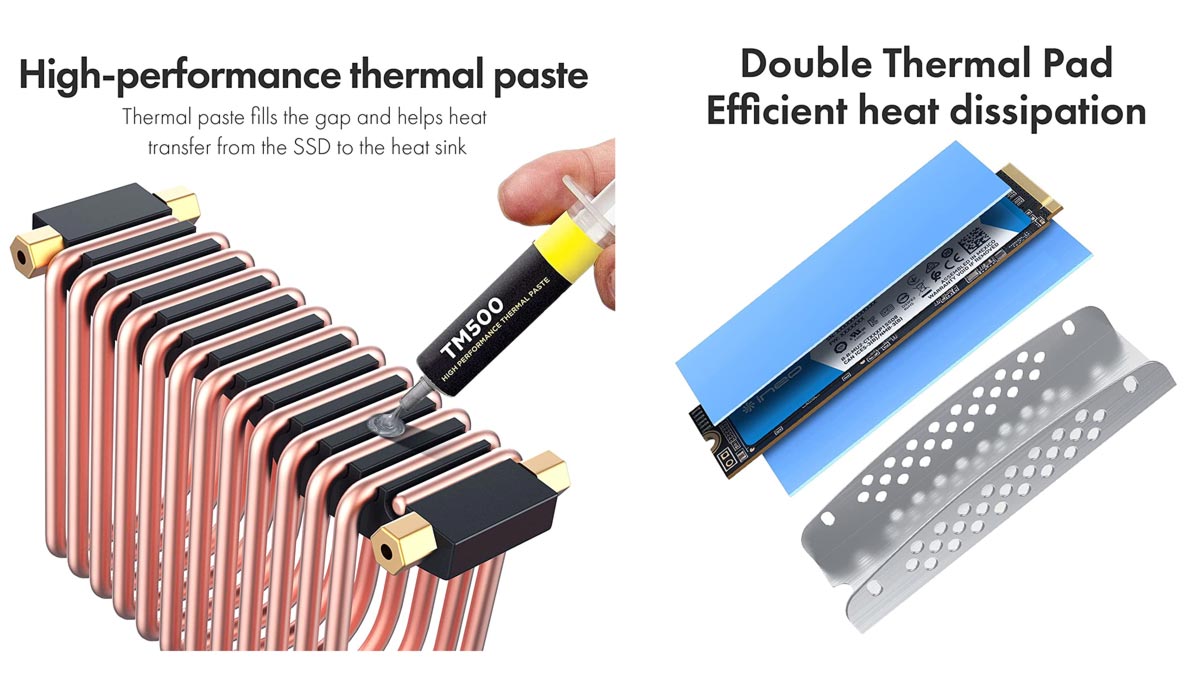This Outlandish Passive M.2 SSD Cooler is Only $20
The Ineo M.2 Pure Cooper Heatsink looks like a futuristic copper pipe-hewn arched tunnel.

Ineo USA is marketing a new M.2 heatsink with a unique design that adds a golden-arched tunnel to your motherboard for $19.99. The Ineo M.2 2280 SSD Pure Cooper Heatsink [M12] features a premium look, with its pure copper heatpipe winding around a sturdy looking anodized aluminum base, and promises to deliver a 10 to 25 degrees Celsius (C) cooling effect to your stressed-out M.2 2280 SSD. Ineo's passive cooler, spotted on Amazon by FanlessTech, is quite accessibly priced at $19.99 and 30 are available at the time of writing.

Looking more closely at Ineo's design, it seems reasonable. The choice of materials seems to be good, but it looks like Ineo could have ground the pipes to match the aluminum heatsink base level (like Gigabyte's Direct-Touch heatpipe tech, and others). Instead, the company suggests filling the resulting dips between heatpipes with lashings of thermal paste, which seems inefficient and a waste. Not to mention that it's rare to hear of applying thermal paste to an SSD. Ineo supplies some "high-performance thermal paste" as well as double-sided thermal pad coverage to ensure your new M.2 SSD is snug in the passive assembly.

Most PC DIYers would probably prefer fewer fans in the system case and simpler solutions without moving parts, especially those interested in steering a build towards a quiet, silent, or even a fully passive design. Perhaps the Ineo M.2 2280 SSD Pure Cooper Heatsink [M12] will be a sweet spot solution, so people don't need to add more fans, and at $19.99 it isn't prohibitively priced. Actually, if it is a success then we will likely see similar designs or even clones, perhaps at cheaper levels. The question is, whether Ineo's quoted 10 to 25 degrees Celsius cooling effect is accurate and if it will be enough to satisfy demanding users in the market for third-party M.2 2280 form factor SSD cooling.
Passive or Active? — Options Abound
Over the last several weeks, we've documented the release of several SSD heatsinks with active cooling: Just yesterday, we reported on the Qiao Sibo blower-fan style SSD cooler, mid-December we saw the ElecGear M11 with an interesting high-pressure fan design, October saw the debut of the Icy Box IB-M2HSF-705 promising 40% cooling improvements over passive designs, and in September Team Group teased the development of the T-Force Cardea Liquid II AiO cooler for M.2 2280 SSDs.
We might think the above coolers are somewhat over the top, as we currently live in the NVMe PCIe 3.0 and 4.0 SSD era. The proliferation of these active coolers hints that the upcoming flood of PCIe 5.0 SSDs with transfer speeds approaching 15 GBps, might be a bit more thermally challenged and could more often have their potential performance thermally throttled while under duress. However, until we have tested some of these SSDs in the real world, it isn't easy to comment on the practicalities of using a simple heatsink vs. an extreme solution like Team Group's Cardea Liquid II AiO cooler - or something in between.
Get Tom's Hardware's best news and in-depth reviews, straight to your inbox.

Mark Tyson is a news editor at Tom's Hardware. He enjoys covering the full breadth of PC tech; from business and semiconductor design to products approaching the edge of reason.
-
-Fran- We're really wasting manufacturing capacity to stuff like this? Really? They even use the NVMe with the sticket on still in the pictures!Reply
Ugh...
Regards. -
Reply
Those stickers usually function as heat spreaders, and the instruction manual generally recommends not removing those stickers. At least, the ones from Samsung and Corsair did.-Fran- said:We're really wasting manufacturing capacity to stuff like this? Really? They even use the NVMe with the sticket on still in the pictures!
Ugh...
Regards. -
NP Cool, but useless. Because consumer nvme sticks do not benefit from any additional cooling. It looks beautiful, though, so I guess it should be evaluated as an ornament, rather than as a device. And in the category of ornaments, it totally beats all this gen Z RGB bling.Reply